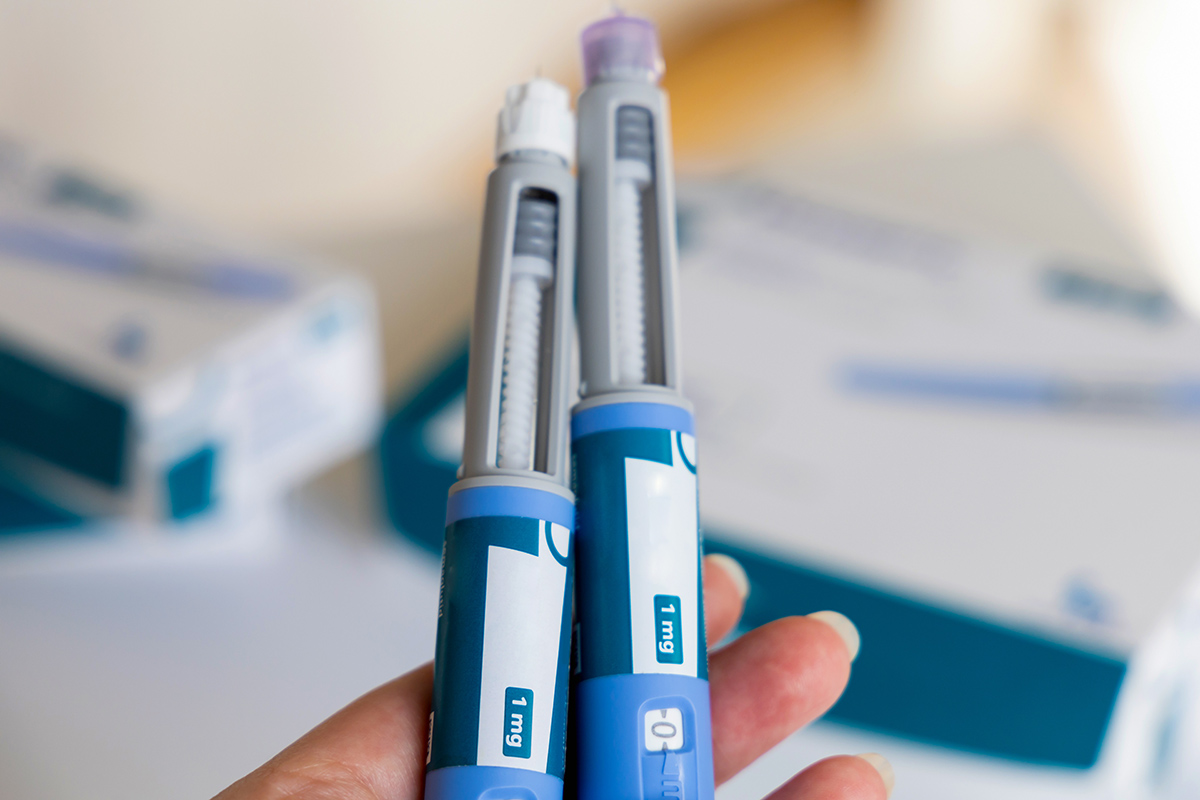The buzz around brands like Ozempic, Wegovy, and Mounjaro is everywhere — especially on social media. These medications, known as glucagon-like peptide-1 (GLP-1) drugs, have surpassed their original FDA-approved use for obesity and type 2 diabetes and are gaining popularity for general weight loss.
For those who are using or thinking about trying GLP-1 medications, it’s essential to understand how they work and how they can impact your health and fitness goals. Here’s a breakdown of what you need to know:
- The recent rise of GLP-1 medications
- What is GLP-1 and how does it work?
- GLP-1 medications and muscle loss
- How to avoid muscle loss with exercise, nutrition, and recovery
- Your fitness journey with Anytime Fitness
The recent rise of GLP-1 medications
GLP-1 drugs (or “agonists”) have been around since 2005, but their popularity has skyrocketed recently as they’ve become more widely available in the U.S. In fact, a recent survey found that about 1 in 8 U.S. adults has used a GLP-1 drug at some point, with around 6% currently using one.
Analysts predict that by 2030, 30 million Americans may be using GLP-1 medications — or around 9% of the population. And there are currently more than 50 anti-obesity drugs in clinical development from about 40 companies.
What is GLP-1 and how does it work?

GLP-1 is a hormone that helps manage blood sugar levels and appetite. While your body produces this hormone naturally, synthetic versions have been developed to mimic the effects of natural GLP-1 and treat type 2 diabetes. Today, several GLP-1 drugs are FDA-approved for treating type 2 diabetes and obesity, such as Ozempic, Wegovy, Soliqua, Trulicity. There are also three that are approved as weight-loss drugs.
When you eat, GLP-1 is released from your intestines, travels to your pancreas, and stimulates insulin release. It also slows down how quickly food leaves your stomach, making you feel full longer.
Here’s a simple breakdown:
- Insulin secretion: GLP-1 signals your pancreas to release insulin, moving glucose from your blood into your cells to provide energy and nourishment.
- Blood sugar control: GLP-1 improves blood sugar management by enhancing insulin efficiency and helping muscle cells absorb glucose, leading to better control of blood sugar levels.
- Appetite regulation: GLP-1 slows down how quickly your stomach empties and makes you feel full longer, helping you eat less overall.
GLP-1 medications are popular for weight loss (note: only three of the many options available are actually FDA-approved as weight-loss drugs). However, it’s important to know how they can affect other potential wellness goals.
GLP-1 medications and muscle loss
While GLP-1 drugs list common side effects like any medication (nausea, vomiting, diarrhea, and so on), one of the more recent findings surrounding GLP-1s is their negative impact on muscle mass. Studies suggest they may contribute to muscle loss if not managed properly, and it’s been well-documented that rapid weight loss often results in muscle loss, no matter the method.
Muscle mass is vital to longevity and directly influences your daily functioning, mobility, energy levels — and even your immune system. In fact, studies show that a person’s muscle mass is a better predictor of overall health than their body mass index (BMI).

How to avoid muscle loss with exercise, nutrition, and recovery
To mitigate muscle loss, it’s crucial to maintain a balanced approach to weight management. And while GLP-1 drugs can help control your appetite, they’re not a cure-all for weight loss. GLP-1 medications should be used in combination with a healthy diet and regular progressive strength training to see real weight-loss results while maintaining muscle mass both in the short and long term.
Exercise and GLP-1s
Incorporating strength training into your routine can help preserve muscle mass. Strength training stimulates muscle protein synthesis and helps with muscle growth and maintenance, even during weight loss. Added bonus: Strength-training exercises help you lose weight because they require the body to burn more calories, and the more muscle mass you have, the more calories the body burns.
Resistance training is particularly beneficial for those on GLP-1 drugs. It helps build and preserve muscle mass. Regular resistance exercises can counteract the muscle loss effects of GLP-1 medications by stimulating muscle growth and improving muscle strength.
5 strength-training workouts to try
Nutrition and GLP-1s
A balanced diet is vital for muscle health. Make sure you’re getting a mix of proteins, carbohydrates, and fats.
Protein: Essential for muscle maintenance and overall health, eating a diet high in protein helps counteract potential muscle loss from GLP-1 drugs, curb hunger, maintain a healthy weight, and speed up muscle recovery after exercise. Incorporate protein-rich foods like lean meats, eggs, legumes, and dairy into every meal.
Carbs and fats: Include healthy fats and complex carbohydrates to fuel your workouts and support overall health. We’re talking nuts, nut butters, avocado, fruits, veggies, healthy oils, oatmeal, and so on.
Calories: Consider transitioning from low-calorie, high-volume options (for example, lettuce-based salads, popcorn, or high-water-content vegetables like zucchini, cucumbers, celery, and peppers) to higher-calorie, lower-volume options (think dried fruits with nuts or nut butters). Because GLP-1s cause a reduced appetite, it’s important to ensure you’re still getting enough calories. Making sure those calories have a higher nutrient density may also help you reach your caloric intake goals and better maintain muscle mass.
Muscle recovery and GLP-1s
Recovery and rest days are actually the part of your training routine that make muscles grow bigger and stronger. That’s right: Muscle growth occurs during the rest and recovery process — not during the workout itself.
Prioritize both active and passive recovery methods, such as:
- 7 Yoga Poses for Stretching After a Workout
- Rest (Kinda) Easy with This Active Recovery Workout
- 10-Minute Foam Rolling Session
Your local Anytime Fitness is also a great place to ask about various recovery options. Make sure you’re getting adequate sleep to allow your muscles to repair and grow. And finally, stay hydrated and focus on foods that boost muscle recovery.
Your fitness journey with Anytime Fitness

We’re here to support your entire health and fitness journey — no matter what that looks like. That means helping you reach your goals effectively and safely. If you’re considering or already taking GLP-1 medications for weight loss, here are some tips:
- Talk to your doctor: They’re the one who should provide personalized healthcare advice and monitor your progress.
- Enlist the help of a Coach: AF Coaches can provide personalized training, nutrition, and recovery guidance. They can also give you an Evolt 360 Body Scan. The 60-second scan gives you more than 40 measurements about your body composition, including muscle mass, so you can get a more holistic picture of your health.
- Set realistic goals: Focus on long-term health rather than quick fixes. Set achievable milestones and celebrate your progress along the way.
- Track your progress: Keep a journal to record your workouts, nutrition, and how you feel. This can help you identify patterns and make necessary adjustments. The free Anytime Fitness App allows you to monitor your progress and get a personalized training plan based on your goals and a strength assessment.
- Listen to your body: Monitor how you feel during and after exercise and make adjustments as needed. A Coach can help tailor your workout plan to align with your new metabolic profile, ensuring you maximize both performance and recovery.
Remember, a successful wellness journey is not just about the tools you use but also the community and support you have along the way. Surround yourself with like-minded individuals, seek guidance from a Coach, and stay committed to your goals.
Discover how we can help you reach your fitness goals effectively and safely through 1:1 personalized coaching.



